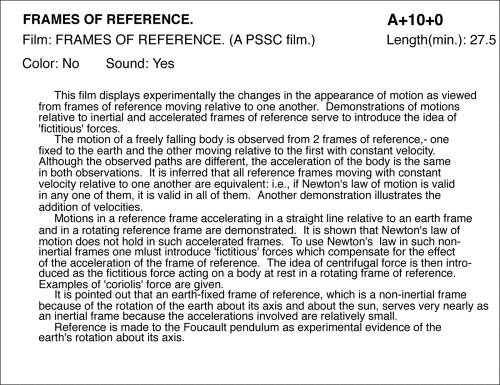Film: "Frames of reference", sound, 28 min.
Primary tabs
Film: FRAMES OF REFERENCE. (A PSSC film.) Although the observed paths are different, the acceleration of the body is the same in both observations. It is inferred that all reference frames moving with constant Color: No Sound: Yes Length(min.): 27.5 velocity relative to one another are equivalent: i.e., if Newton's law of motion is valid in any one of them, it is valid in all of them. Another demonstration illustrates the addition of velocities. Motions in a reference frame accelerating in a straight line relative to an earth frame and in a rotating reference frame are demonstrated. It is shown that Newton's law of motion does not hold in such accelerated frames. To use Newton's law in such non- The motion of a freely falling body is observed from 2 frames of reference,- one fixed to the earth and the other moving relative to the first with constant velocity. relative to inertial and accelerated frames of reference serve to introduce the idea of 'fictitious' forces. This film displays experimentally the changes in the appearance of motion as viewed from frames of reference moving relative to one another. Demonstrations of motions inertial frames one mlust introduce 'fictitious' forces which compensate for the effect of the acceleration of the frame of reference. The idea of centrifugal force is then introduced as the fictitious force acting on a body at rest in a rotating frame of reference. Examples of 'coriolis' force are given. It is pointed out that an earth-fixed frame of reference, which is a non-inertial frame because of the rotation of the earth about its axis and about the sun, serves very nearly as an inertial frame because the accelerations involved are relatively small. Reference is made to the Foucault pendulum as experimental evidence of the earth's rotation about its axis.
UCB Index:
A+10+0
UCB Taxonomy:
Popularity:
- Log in to post comments

